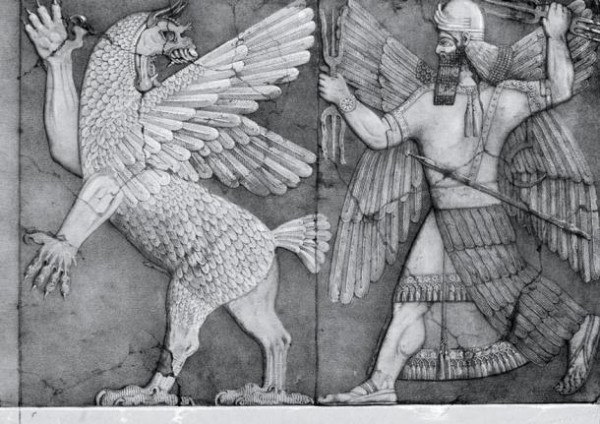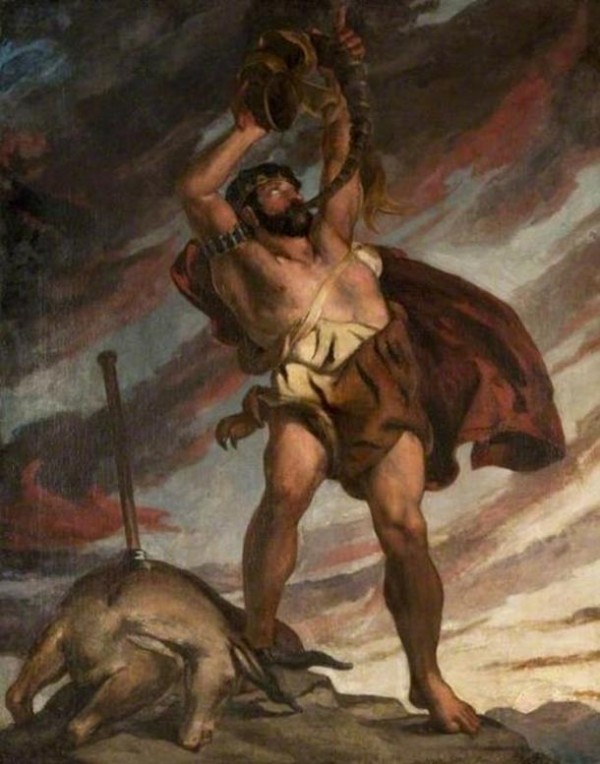
Ninurta with his thunderbolts pursues Anzû, who has stolen the Tablet of Destinies from Enlil's sanctuary. (Austen Henry Layard Monuments of Nineveh, 2nd Series, 1853). ( Public Domain )
ishtartv.com - ancient-origins.net
CALEB STROM, 27 OCTOBER, 2018
Ninurta was a Mesopotamian deity associated with war, agriculture, and the scribal arts. He could be thought of as a defender of civilization against chaos. Ninurta was originally revered in southern Mesopotamia and later in the north under the Assyrian kings. He remained a prominent deity until the fall of the Assyrian Empire. His primary symbol was the
plow.
Migration from Southern to Northern Mesopotamia
Ninurta originally emerged as an agricultural deity in ancient
Sumer
. As Mesopotamia became more militarized, he also became associated with warfare. Genealogically, he was the son of the god Enlil. His original sanctuary was a temple in the city-state of Nippur. Ninurta remained popular in the Assyrian north because of his association with war.
Under the Assyrian
Empire
, he gained importance as a warrior deity as well as a protector and healer. He was associated with Assur and some sources identify him as a son of Assur, the Assyrian national god. In addition to implying an identification of Assur with Enlil, it also demonstrates how important Ninurta was to the Assyrians. Some Assyrian rulers even added Ninurta’s name to their own names. One example would be Tukulti-Ninurta I. After the fall of the Assyrian Empire, Ninurta declined in importance, possibly because of his association with the Assyrian Empire, of which most of the direct successors to the Assyrians had a rather dim view.
Myths about Ninurta
In an era before civilization, a hideous demon called the Asag caused rivers to boil so that all the fish died. He was also accompanied by a ferocious army of stone warriors. The only one who could stand against the demon was Ninurta. Ninurta slew the Asag and used the defeated army of stones to build up the mountains in such a way that water would flow into the Tigris and the Euphrates, allowing for civilization to be built up along their banks.
There is an interesting theme in this story of hostile creatures (the stones) from the mountains threatening the lowlands. The Asag itself is also associated with the mountains and is said to have mated with the mountains. It has been suggested that this myth may reflect
tension between people dwelling in the Mesopotamian basin and the inhabitants of the Zagros Mountains to the east. This myth also demonstrates Ninurta’s role as a protector of
civilization, or at least potential civilization.
In another story that also takes place in primordial times before humans, Anzu, a giant lion-headed bird monster from the mountains, steals the Tablet of Destinies from Enlil, the chief of the gods. Possession of the tablet gives Anzu supreme power over the universe. The gods, terrified, turn to Ninurta, the mighty warrior and the son of Enlil. Ninurta sets out to defeat Anzu, retrieve the Tablet of Destinies, and restore order to the cosmos. Ninurta is successful in slaying Anzu and returning the Tablet of Destinies to his father
.This story also has the same underlying theme of order and civilization versus chaos. Because the people of the Zagros Mountains were more often pastoralists and the Mesopotamians were often sedentary farmers and city-dwellers, they tended to view the mountains as a realm beyond the reach of order and civilization. Thus, many threats to cosmic order were depicted as coming from there.
Possible Meaning of the Myths of Ninurta
In both the above stories, Ninurta is depicted as a warrior who protects the cosmos and civilization from the forces of chaos. After he slays the Asag demon, he uses the bodies of the slain stone warriors of the Asag to make the world useful for mankind.
Ninurta – God of Civilization?
Ninurta is usually thought of as a god of war and agriculture. Though he is occasionally depicted as having scribal duties, he is not usually considered to be a god of wisdom. Nonetheless, it is Ninurta in Mesopotamian mythology who helped to make the world safe for civilization and helped maintain order within it.
1853 restoration of what the city of Kalhu, Ninurta's main cult
center in the Assyrian Empire, might have originally looked like, based on the excavations of the British archaeologist Austen Henry Layard there in the 1840s. ( Public Domain )
Ninurta’s roles as a warrior and as a god of agriculture appear to both be connected to his role as a deity who made civilization possible. It could be said that the accumulation of wisdom was made possible by Ninurta because he arrested chaotic forces, thus allowing for a calm, orderly place where wisdom could accumulate in the libraries and temples of Mesopotamia. Any state or empire that has acted as a stabilizing influence that brought lasting peace and allowed for art and learning to flourish could be said to be carrying out the role of Ninurta.
--------------
References
George, A. R. "The God Ninurta in the Mythology and Royal Ideology of Ancient Mesopotamia." (2005): 307-309.
George, Andrew R. "Marduk and the Cult of the Gods of Nippur at Babylon." Orientalia 66.1 (1997): 65-70.
Hallo, William W. "The Return of Ninurta to Nippur." (1981): 253-257.
Lambert, Wilfred George. "The God Aššur." Iraq 45.1 (1983): 82-86.
Lambert, Wilfred George. "Tukulti-Ninurta I and the Assyrian King List." Iraq 38.2 (1976): 85-94.
Black, Jeremy, and Anthony Green. Gods, Demons and
Symbols . University of Texas press, 1992.
Wazana, Nili. "Anzu and Ziz: Great Mythical Birds in Ancient Near Eastern, Biblical, and Rabbinic Traditions." Journal of the Ancient Near Eastern Society 31.1 (2009): 2460.
Postgate, J. Nicholas. "The land of Assur and the yoke of Assur." World Archaeology 23.3 (1992): 247-263.

‘Nimrod’ (1832) by David Scott. Nimrod, the "great hunter" mentioned in Genesis 10:8–12, is believed by many scholars to be inspired by either Ninurta himself or the Assyrian king Tukulti-Ninurta I, named after him. ( Public Domain )
|